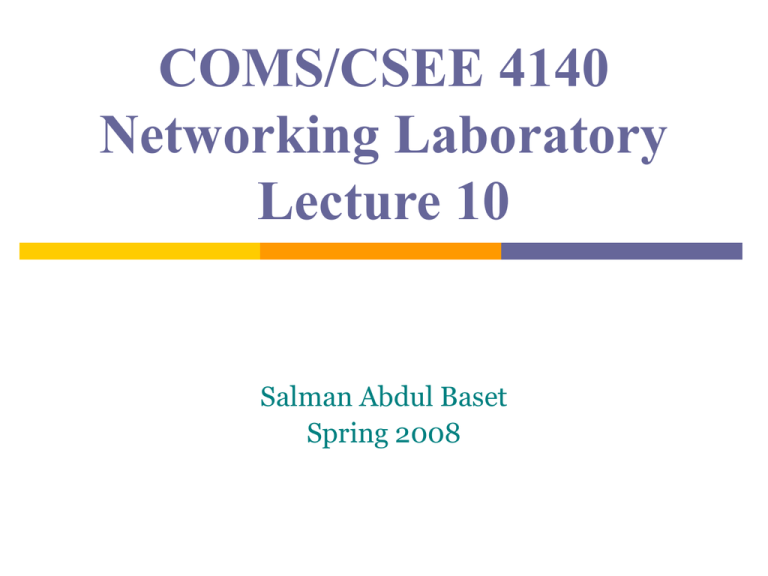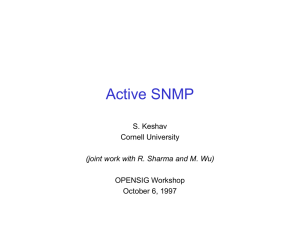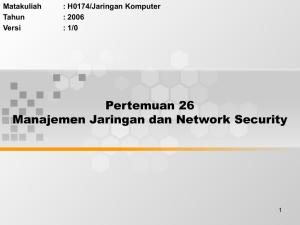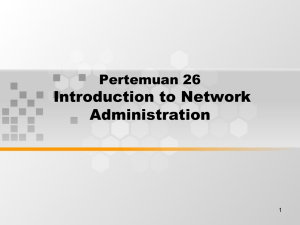COMS/CSEE 4140 Networking Laboratory Lecture 10 Salman Abdul Baset
advertisement

COMS/CSEE 4140
Networking Laboratory
Lecture 10
Salman Abdul Baset
Spring 2008
Announcements
Prelab 9 and Lab report 8 due next week before
your lab slot
Weekly project reports due before Friday 5pm
2
Agenda
ASN.1
types, values, structured types
SNMP
SNMP agents, managers
MIB
Interaction
SNMP v1, v2, v3
3
ASN.1
Abstract syntax notation one
Formal notation for describing data structures and
message formats
Type definitions, value definitions, combined
Predefined basic types
Constructed types
BOOLEAN, INTEGER, OCTET STRING, BIT STRING, REAL,
ENUMERATED, CHARACTER STRING, OBJECT IDENTIFIER
SEQUENCE, SEQUENCE OF, CHOICE
Arbitrary nesting of types and sub-types
Encoding
4
ASN.1 types and values
Type definitions
Value definitions
NumberofStudents ::= INTEGER
PassorFail ::= BOOLEAN
GradeType ::= ENUMERATED {A, B, C}
PointsScored ::= REAL
Image ::= BIT STRING
Data ::= OCTET STRING
studentsMonaySession NumberofStudents ::= 9
passCourse PassorFail ::= TRUE
Combine type value definitions
StudentType ::= INTEGER {
ugrad (0)
ms
(1)
phd
(2)
}
5
ASN.1 structured types and values
}
StudentRecord ::= SEQUENCE {
regNo
INTEGER,
type definition
numClasses INTEGER OPTIONAL,
fathersName STRING
}
John StudentRecord ::= {
regNo
1234,
value definition
numClasses 5,
fathersName Don
}
}
studentNo ::= SEQUENCE OF regNo
studentNo ::= {1234, 5678, 9012}
(type definition)
(value definition)
6
ASN.1 structured types and values
CHOICE: select a variable from a known
collection of possible variables
majorType ::= CHOICE {
engineering
IA5 String,
arts
IA5 String,
economics
IA5 String
}
s1Major ::= engineering : computer science
s2Major ::= engineering : electrical
s3Major ::= economics : freakonomics
7
ASN.1 Module
MyModule DEFINITIONS ::=
BEGIN
--ASN.1 definitions
END
8
ASN.1 OBJECT IDENTIFIER (MIB)
Define an information object
that is managed at the
international level
internet OBJECT IDENTIFIER ::=
{ iso org(3) dod(6) 1 }
.
root
iso(1)
org (3)
dod (6)
9
ASN.1 MACRO (MIB)
OBJECT-TYPE MACRO ::=
BEGIN
TYPE NOTATION ::= "SYNTAX" type (TYPE ObjectSyntax)
"ACCESS" Access
"STATUS" Status
VALUE NOTATION ::= value (VALUE ObjectName)
Access ::= "read-only"
| "read-write"
| "write-only"
| "not-accessible"
Status ::= "mandatory“
| “current"
| "optional"
| "obsolete"
END
10
ASN.1 Examples (MIB)
RFC 1155
internet OBJECT IDENTIFIER ::= { iso org(3) dod(6)
1 }
1.3.6.1.
Counter ::= [APPLICATION 1] IMPLICIT INTEGER
(0..4294967295)
TimeTicks ::= [APPLICATION 3] IMPLICIT INTEGER
(0..4294967295)
IpAddress ::= [APPLICATION 0] IMPLICIT OCTET
STRING (SIZE (4))
NetworkAddress ::= CHOICE { internet IpAddress }
11
ASN.1 Encoding
ASN.1 defines syntax and not how to encode
them
ASN.1 encoding rules
Basic encoding rules (BER)
DER encoding rules (DER)
Canonical encoding rules (CER)
XML encoding rules (XER)
Packet encoding rules (PER)
Generic string encoding rules (GSER)
12
Agenda
ASN.1
types, values, structured types
SNMP
SNMP agents, managers
MIB
Interaction
SNMP v1, v2, v3
13
SNMP background
Need for administration of TCP/IP network
Goals
number of machines (scale)
implementations
cover protocol layers
SNMPv1, SNMPv2, SNMPv3
14
Simple Network Management
Protocol
SNMP is a framework that provides facilities for managing and
monitoring network resources on the Internet.
Components of SNMP:
SNMP agents (port 161)
SNMP managers (port 162)
Management information bases (MIBs)
SNMP protocol itself
SNMP agent
SNMP
manager
SNMP
protocol
messages
SNMP agent
SNMP agent
15
Simple Network Management
Protocol
SNMP agent is software that runs on a piece of network
equipment (host, router, printer, or others) and that
maintains information about its configuration and current
state in a database.
Management Information Bases (MIBs) describes the
information in the database.
MIB, MIB-II (RFC 1213)
SMI defines sets of related objects in a MIB
SNMP manager is an application program that contacts an
SNMP agent to query or modify the database at the agent.
SNMP protocol is the application layer protocol used by
SNMP agents and managers to send and receive data.
SNMPv1, v2, v3
16
Structure of management information
(SMI)
Adapted subset of ASN.1
Define sets of related managed objects (using
MACRO)
Module definitions
Object definitions
MODULE-IDENTITY
OBJECT-TYPE
Notification definitions
NOTIFICATION-TYPE
17
MIBS
A MIB specifies the managed objects
MIB is a text file that describes managed objects using
the syntax of ASN.1
What is a managed object?
interface, TCP stack (RTO, congestion control alg.), ARP etc.
In Linux, MIB files are in the directory
/usr/share/snmp/mibs
Multiple MIB files
MIB-II (defined in RFC 1213) defines the managed objects of
TCP/IP networks
18
Managed Objects
Each managed object is assigned an object identifier
(OID)
The OID is specified in a MIB file.
An OID can be represented as a sequence of integers
separated by decimal points or by a text string:
Example:
1.3.6.1.2.1.4.6.
iso.org.dod.internet.mgmt.mib-2.ip.ipForwDatagrams
When an SNMP manager requests an object, it sends the
OID to the SNMP agent.
19
Organization of managed objects
Organized in a tree-like
hierarchy
OIDs reflect the
structure of the
hierarchy.
Each OID represents a
node in the tree.
The OID 1.3.6.1.2.1
(iso.org.dod.internet.m
gmt.mib-2) is at the top
of the hierarchy for all
managed objects of the
MIB-II.
Manufacturers of
networking equipment
can add product specific
objects to the hierarchy.
.
root
iso(1)
org (3)
dod (6)
internet (1)
directory (1)
mgmt (2)
experimental (3)
private (4)
mib-2 (1)
system (1)
at (3)
interface (2)
icmp (5)
ip (4)
ipForwDatagrams (6)
tcp (6)
udp (7)
egp (8)
snmp (11)
transmiss
20
Definition of managed objects in a
MIB
Specification of ipForwDatagrams in MIB-II.
ipForwDatagrams OBJECT-TYPE
SYNTAX Counter
ACCESS read-only
STATUS current
DESCRIPTION
"The number of input datagrams for which this
entity was not their final IP destination, as a
result of which an attempt was made to find a
route to forward them to that final destination.
In entities which do not act as IP Gateways, this
counter will include only those packets which were
Source-Routed via this entity, and the SourceRoute option processing was successful."
::= { ip 6 }
21
SNMP Interactions
Interactions in SNMP
Management Station
Managed System
SNMP Manager
Process
SNMP Agent
Process
Traps
SNMP messages
Data
Access
objects
Traps
Replies
Queries
SNMP
MIB
SNMP
UDP
UDP
IP
IP
IP Network
22
SNMP Protocol
SNMP manager and an SNMP agent
communicate using the SNMP protocol
Generally: Manager sends queries and agent responds
Exception: Traps are initiated by agent.
23
Traps
Traps are messages that are asynchronously sent
by an agent to a manager
Traps are triggered by an event
Defined traps include:
linkDown: Even that an interface went down
coldStart - unexpected restart (i.e., system crash)
warmStart - soft reboot
linkUp - the opposite of linkDown
(SNMP) AuthenticationFailure
…
24
SNMP Protocol
Get-request. Requests the values of one or more
objects
Get-next-request. Requests the value of the next
object, according to a lexicographical ordering of OIDs.
Set-request. A request to modify the value of one or
more objects
Get-response. Sent by SNMP agent in response to a
get-request, get-next-request, or set-request message.
Trap. An SNMP trap is a notification sent by an SNMP
agent to an SNMP manager, which is triggered by
certain events at the agent.
25
SNMP Versions
Three versions are in use today:
SNMPv1 (1990)
SNMPv2c (1996)
Adds “GetBulk” function and some new types
Adds RMON (remote monitoring) capability
SNMPv3 (2002)
SNMPv3 started from SNMPv1 (and not SNMPv2c)
Addresses security
All versions are still used today
Many SNMP agents and managers support all
three versions of the protocol.
26
Format of SNMP Packets
SNMPv1 Get/Set messages:
Version
SNMP PDU
Community
Cleartext string that is
used as a password
PDU type, e.g.:
32: SNMPv1 Get
64: SNMPv2 Get
Unique ID to match
requests with replies
Sequence of name-value
pairs
PDU Type
Request ID
Error Status
Error Index
Object 1, Value 1
Object 2, Value 2
...
27
SNMP Security
SNMPv1 uses plain text community strings for
authentication as plain text without encryption
SNMPv2 was supposed to fix security problems,
but effort derailed (The “c” in SNMPv2c stands
for “community”).
SNMPv3 has numerous security features:
Ensure that a packet has not been tampered with (integrity),
Ensures that a message is from a valid source (authentication)
28
Ensures that a message cannot be read by unauthorized
(privacy).
SNMP Security
Security model of SNMPv3 has two components:
1.Instead of granting access rights to a community,
SNMPv3 grants access to users.
2. Access can be restricted to sections of the MIB
(Version-based Access Control Module (VACM).
Access rights can be limited
by specifying a range of valid IP addresses for a user or
community,
or by specifying the part of the MIB tree that can be accessed.
29
Security levels in SNMPv2
SNMP has three security levels:
noAuthNoPriv: Authentication with matching a user
name.
authNoPriv: Authentication with MD5 or SHA message
digests.
authPriv: Authentication with MD5 or SHA message
digests, and encryption with DES encryption
Compare this to SNMPv1 and SNMPv2c:
SNMPv1, SNMPv2: Authentication with matching a
community string.
30
SNMP RFC
RFC 2576 coexistence between SNMPv1, v2, v3
31
Conclusion
ASN.1
Abstract notation for defining types and values
SNMP
uses ASN.1
manager and agent
SNMPv1, v2 (GetBulk), v3 (security)
32



